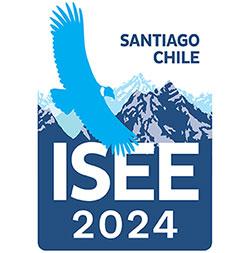ANNUAL CONFERENCE LOCATION
Sheraton Santiago Hotel and Convention Center
Ave Santa Maria 1742, Santiago, Chile
Phone: +56-2-22335000
Website
LANGUAGE
The official language of the 36th ISEE Annual Conference is English.
TIME ZONE
During ISEE 2024, Chile will be operating on Chile Standard Time (CLT), which is 4 hours behind GMT (UTC-4).
VISA REQUIREMENT
Please check the Visa Information page.
LIABILITY & INSURANCE
The Annual Conference Organizing Secretariat and Organizers cannot accept liability for personal accidents or loss of or damage to the private property of participants. Upon registration, participants agree that neither the Organizing Committee nor the Organizing Secretariat assumes any liability. Participants are advised to take out their own personal travel and health insurance for their trip.
SAFETY & SECURITY
Please do not leave bags or suitcases unattended at any time, whether inside or outside the session halls. Hotels strongly recommend that you use their safety deposit boxes for your valuables.
If you are a victim of crime, call the local police at 133. If you are injured and require immediate medical attention, call emergency medical services at 131.
CLIMATE
August is one of the colder months in Santiago. Daytime temperatures typically range from 10°C to 18°C (50°F to 64°F). However, it can get cooler in the evenings and early mornings, with temperatures dropping to around 3°C to 10°C (37°F to 50°F). Since August is a relatively dry month, rainfall is minimal, and you can expect only a few rainy days during the month.
Despite the cooler temperatures, Santiago still enjoys a fair amount of sunshine in August. You can expect clear or partly cloudy skies, making it a pleasant time to explore the city.
Given the cooler temperatures, it’s advisable to pack warm clothing, including layers, a medium-weight jacket or coat, and comfortable walking shoes if you plan to explore the city. Don’t forget to check the local weather forecast closer to your travel dates for the most accurate and up-to-date information on weather conditions during your stay.
CLOTHING
The dress code for ISEE 2024 is business formal for all occasions unless stated otherwise.
ELECTRICITY
In Chile, there are two associated plug types, types C and L. Chile operates on a 220V supply voltage and 50Hz. International travelers are advised to bring their own power adapter.

CURRENCY & EXCHANGE
The legal currency of Chile is the Chilean peso. Currently there are coins of 10, 50, 100, and 500 pesos and banknotes of 1,000, 2,000, 5,000, 10,000, and 20,000.
The easiest way to obtain cash is by using ATMs, which operate under the “Redbank” sign. These cashpoint machines take Visa and MasterCard, and permit transactions up to 250.- US Dollars. However, they are only available in major cities.
MasterCard, Visa, American Express, and Diners Club cards are sporadically accepted throughout the country, though visitors should not count on being able to use their credit card in rural areas. Shop owners will sometimes charge more for purchases made with a credit card.
Unlike some other South American countries, US dollars are rarely accepted in Chile except in some hotels. Therefore, we recommend you have some pesos in cash. The government does not regulate the market of foreign currency in Chile. You can exchange money at any established “Casa de Cambio” at market-driven exchange rates. They are common in commercial areas as well as in shopping malls. Please note 100 US Dollar bills are not usually accepted due to past problems with counterfeiting.
TAX
VAT is payable on the transfer of goods and the provision of services at a 19% rate. Foreigners are exempt from paying local sales tax (19%) IVA if they pay in US dollars in Chile. However, it is usually only some hotels that accept US dollars.
TIPPING
Tipping is discretionary in Chile and is seen as a reward for good service. Tips should be in Chilean pesos. If you do leave tips in US dollars – bills only – in a hotel, make sure the bills are unmarked and undamaged. 10% is the average restaurant tip. Cab drivers do not expect to be tipped, but they appreciate the fare being rounded off.
